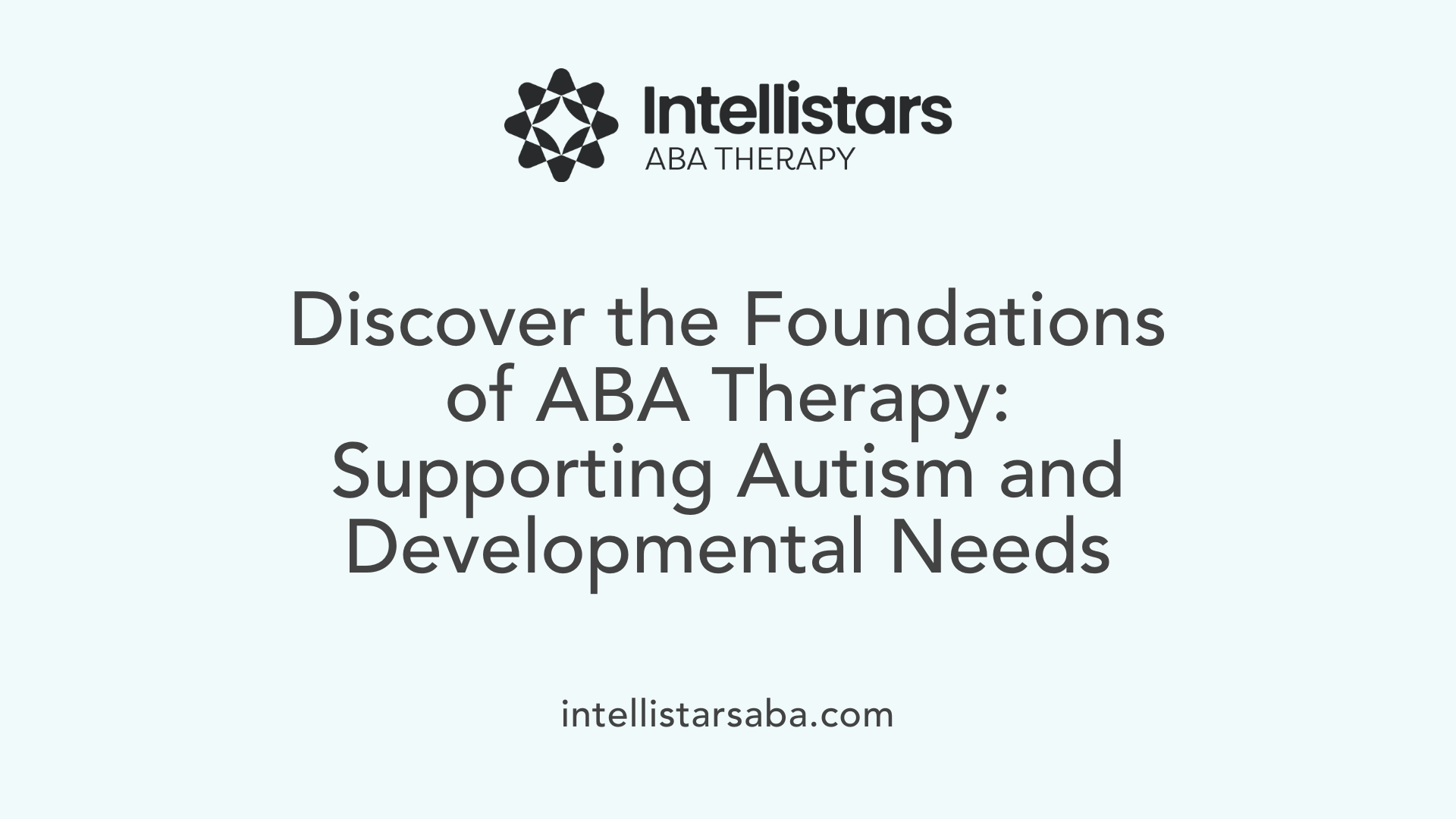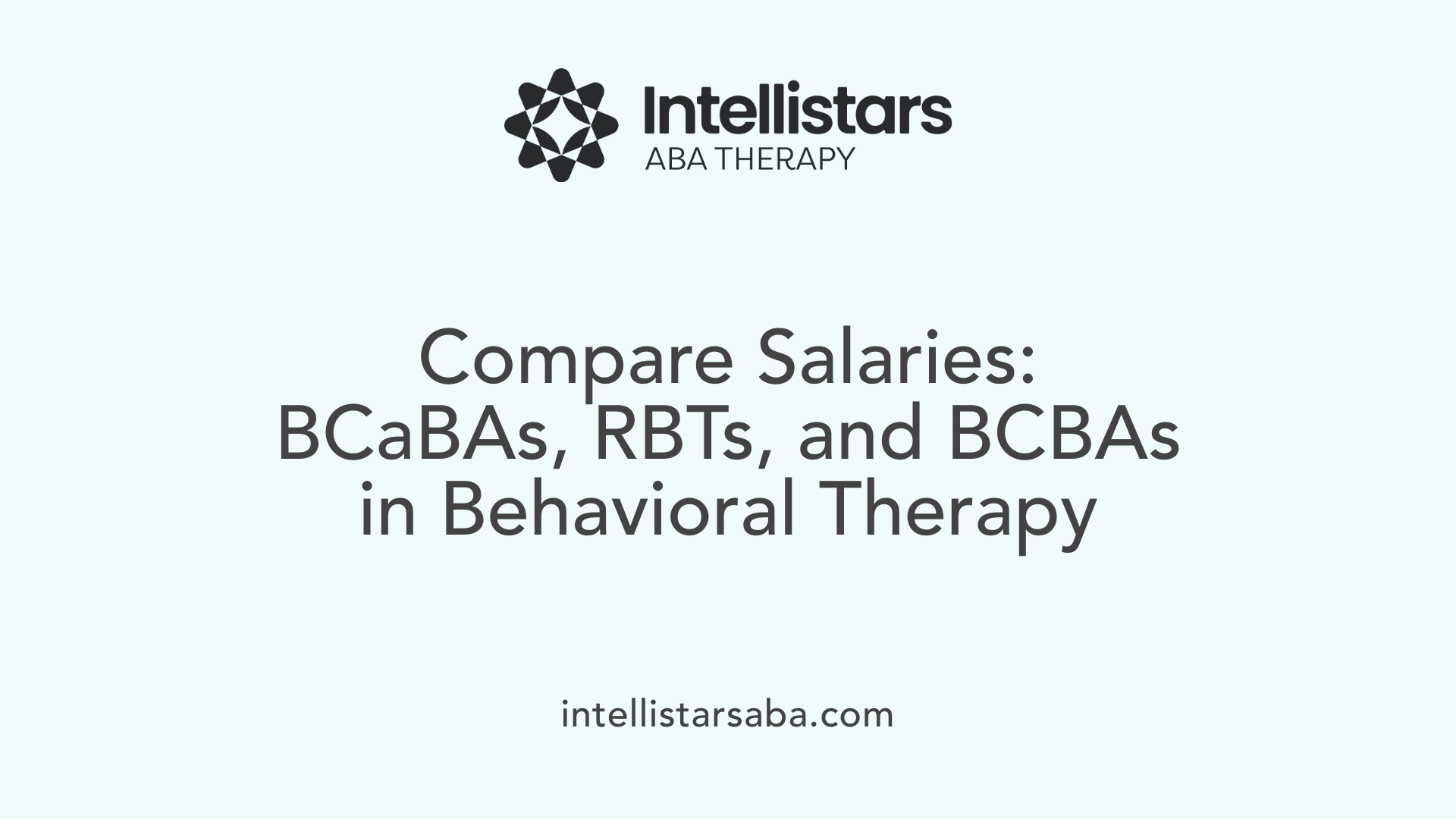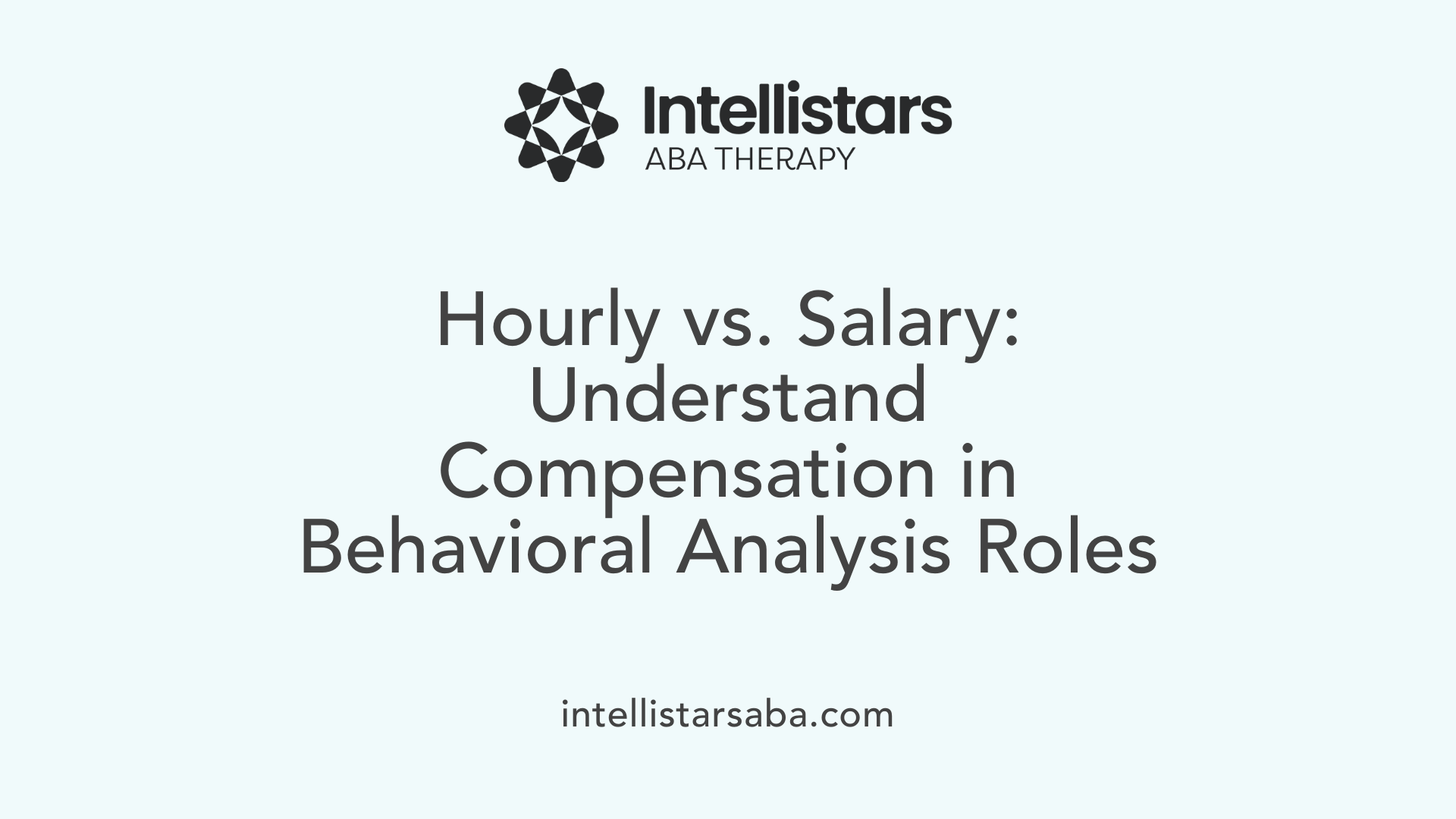Understanding the Role and Compensation Landscape of BCaBAs
Applied Behavior Analysis (ABA) therapy plays a crucial role in supporting individuals with autism by utilizing behavior-focused strategies to foster skill development and improve quality of life. The professionals behind these efforts are Board Certified Assistant Behavior Analysts (BCaBAs), who support BCBAs in executing and managing treatment plans. This article delves into the average BCaBA salary across the U.S., how it varies by state, and factors influencing compensation. It offers readers a comprehensive view of BCaBA earnings, contextualized within the broader behavioral health field and geographic market demands as of 2024.
What Is ABA Therapy and Who Provides It?

Definition and Focus of ABA Therapy
Applied Behavior Analysis (ABA) is a science-based therapeutic approach primarily used to support individuals with autism. It focuses on improving specific skills such as communication, social interactions, and daily living activities, while aiming to reduce behaviors that may hinder learning or quality of life. The therapy relies on principles of learning and behavior, incorporating methods like positive reinforcement and careful data tracking.
Role of BCaBAs and BCBAs in Therapy Delivery
ABA therapy is delivered by a team of professionals, including Board Certified Assistant Behavior Analysts (BCaBAs) and Board Certified Behavior Analysts (BCBAs). BCBAs are highly trained specialists who assess the individual’s needs, develop tailored treatment plans, and supervise the implementation of therapy. BCaBAs work under the supervision of BCBAs to carry out therapy sessions and collect data. Additionally, trained therapists and sometimes family members play an active role in reinforcing skills throughout daily routines.
Goals and Methods Used in ABA
The primary goal of ABA therapy is to enhance positive and functional behaviors while decreasing negative or challenging ones to improve overall quality of life. Methods include individualized assessments, breaking down complex skills into manageable steps, and using consistent reinforcement to encourage progress. Therapy is personalized, evolving based on ongoing data to ensure it meets the unique needs of each individual.
Average BCaBA Salary Overview in the U.S.

What is the national average BCaBA salary?
The average salary for a Board Certified Assistant Behavior Analyst (BCaBA) in the United States is approximately $65,978 per year. This figure serves as a useful benchmark for individuals exploring a career in applied behavior analysis at the assistant certification level.
How do monthly, weekly, and hourly salaries break down?
Understanding BCaBA earnings beyond the annual figure provides a more practical view of income. On average:
- Monthly earnings would be around $5,498.
- Weekly wages typically amount to approximately $1,269.
- Hourly rates generally calculate to about $32, assuming a 40-hour work week.
These breakdowns help aspiring BCaBAs and current practitioners gauge their compensation level relative to their work hours.
How current and reliable is the salary data?
The salary information is based on data updated as recently as October 9, 2024. This recent update ensures the salary figures reflect current market conditions and trends, making the data reliable for both job seekers and employers.
With salaries varying across states and influenced by factors like demand and cost of living, this up-to-date data offers a solid foundation for understanding what BCaBAs can expect in terms of compensation nationwide.
State Variability: Highest Paying States for BCaBAs
Which States Pay BCaBAs the Most?
The average salary for Board Certified Assistant Behavior Analysts (BCaBAs) varies significantly across the United States. Among the top-paying states, Washington leads with an average annual salary of $71,308, followed closely by Maryland at $69,661 and New York at $68,684. These figures surpass the national average BCaBA salary of $65,978, highlighting the financial advantages in these regions.
Why Do BCaBA Salaries Differ by State?
Several factors contribute to the salary differences seen across states. One primary driver is the cost of living—states like Washington and New York have higher living costs, which often necessitate increased salaries to attract qualified professionals. Additionally, demand for ABA services often correlates with population density and urbanization; states with larger urban centers tend to offer higher wages due to the greater need for qualified BCaBAs.
Economic factors such as state funding for healthcare and education programs also influence salary levels. States investing more in behavioral health services, especially for autism therapy and developmental disabilities, tend to offer better compensation. Moreover, local policies, the presence of private sector employers, and competitive professional markets in certain states create salary variability.
Overall, geographic location remains a critical influence on BCaBA compensation, reflecting the dynamic balance between demand for services, cost of living, and employer resources across different states.
Comparing BCaBA Salaries with Related Behavioral Roles

How do BCaBA salaries compare with those of Registered Behavior Technicians and BCBAs?
The average annual salary for a Board Certified Assistant Behavior Analyst (BCaBA) in the U.S. is approximately $65,978. This figure sits between the earnings of Registered Behavior Technicians (RBTs) and Board Certified Behavior Analysts (BCBAs), reflecting the varied levels of responsibility and certification.
RBTs, who typically provide direct therapy under supervision, tend to have lower salaries, often starting around $38,000 annually, depending on geographic location and demand. In contrast, BCBAs, holding the highest certification in applied behavior analysis, command significantly higher salaries with an average of about $89,075 per year. Experienced BCBAs can earn up to $149,000 per year, underscoring the premium placed on advanced expertise and leadership roles.
What are the salary differences by role and certification level?
Salaries increase in tandem with certification level and experience. While BCaBAs earn roughly $66,000 per year, career growth toward BCBA certification typically leads to higher earnings.
Certification impacts salary brackets as follows:
| Role | Average Annual Salary | Typical Experience Level |
|---|---|---|
| Registered Behavior Technician (RBT) | $38,000 - $45,000 | Entry-level, under BCaBA or BCBA supervision |
| Board Certified Assistant Behavior Analyst (BCaBA) | ~$65,978 | Mid-level, requires bachelor’s degree and certification |
| Board Certified Behavior Analyst (BCBA) | $89,075 - $149,000 | Advanced-level, requires master’s degree and certification |
The distinctions in salary reflect different responsibilities; BCBAs often oversee treatment plans, supervise BCaBAs and RBTs, and manage programs. Additionally, geographic factors and employer type further influence compensation.
Overall, advancing from an RBT through BCaBA to BCBA generally leads to substantial salary growth, with certification and experience being the main salary drivers.
Impact of Geographic Location on BCaBA Salaries
How Does Geographic Location Affect BCaBA Salaries?
Geographic location plays a significant role in determining BCaBA salaries across the United States. Urban areas with high demand for Applied Behavior Analysis (ABA) services generally offer higher pay compared to rural regions. This disparity is often influenced by the cost of living and the concentration of healthcare and professional services.
Urban Versus Rural Salary Differences
Urban centers tend to offer BCaBAs more attractive salaries. For example, San Francisco, CA, is among the top-paying cities with average annual salaries nearing $93,846. Similarly, smaller cities like Santa Cruz and Redwood City in California provide even higher averages, exceeding $110,000. In contrast, rural areas typically report lower salaries, reflecting fewer job opportunities and a lower cost of living.
Cost of Living and Demand Impact
Higher salaries in metropolitan areas often correlate with increased living costs and a corresponding demand for specialized services. Regions like Alaska, which boasts the highest average BCaBA salary at $99,394, combine both these factors. Despite Alaska's geographic remoteness, the elevated cost of living and need for qualified professionals drive wages upward.
Examples from High-Paying States
States such as California and Alaska illustrate this geographic influence well. California offers robust salaries, particularly in urban hubs, with averages around $89,178 to over $110,000 in select cities. Alaska, with its high living expenses and demand, leads the states in average BCaBA pay. Maryland and New York also provide competitive salaries, solidifying the pattern of geographic disparities based on urbanization and cost of living.
Overall, understanding how location affects BCaBA compensation is crucial for professionals planning their careers or relocations within the behavioral analysis field.
Factors Influencing BCaBA and BCBA Salaries
How do experience levels affect salaries for BCaBA and BCBA professionals?
Experience plays a major role in salary variations. Entry-level BCaBAs can expect starting salaries around $38,000 to $47,500 annually, while BCBAs typically begin around $50,000 to $60,000. With several years of experience, BCBA salaries can increase substantially, reaching up to $149,000 annually for highly experienced professionals. This progression reflects the greater expertise and responsibilities gained over time.
What impact does education have on earning potential?
Higher education levels often correlate with increased salaries. For BCBAs, salaries range broadly from $70,000 to $120,000 depending on educational qualifications. Advanced degrees and certifications boost earning capacity by enabling access to specialized roles and higher paying positions.
How does the industry sector influence compensation?
Industry sectors heavily influence salary ranges. BCBA and BCaBA salaries tend to be higher in private sector roles, where earnings typically fall between $80,000 and $120,000. Conversely, government and non-profit sectors generally offer lower salaries ranging from $60,000 to $80,000. High-paying sectors include healthcare, professional services, and government roles, reflecting specialized demand and budgets.
In what ways do employer types affect salary?
Employer type is a crucial salary determinant. Private employers often pay more compared to educational or government institutions. Leadership positions such as Behavior Analyst Directors or Behavioral Health Directors can command salaries upwards of $84,000 to $112,000, reflecting added supervisory responsibilities and administrative roles.
How do demand and specialization impact salaries?
Demand for BCaBAs and BCBAs is growing by approximately 14% annually. High-demand regions, especially urban areas with a strong need for ABA services and higher costs of living, offer elevated salaries. Specialized skills and scope of practice, such as telehealth or advanced clinical expertise, further enhance earning potential. Negotiation skills also play a role in individual compensation.
| Factor | Influence on Salary | Example Range/Notes |
|---|---|---|
| Experience | Entry-level to senior level salary growth | $38,000 - $149,000 annually |
| Education | Higher degrees increase earning potential | $70,000 - $120,000 depending on education |
| Industry Sector | Private pays more than public/non-profit | Private: $80K-$120K; Gov/Non-profit: $60K-$80K |
| Employer Type | Leadership roles command higher salaries | Directors earning $84K - $112K+ |
| Demand & Location | High-demand urban areas offer top salaries | Salary varies widely with geography and demand |
High-Paying Industries and Roles within Behavioral Analysis

Which Industries Offer the Highest Salaries for BCaBAs and BCBAs?
Behavioral analysts find some of the best pay in government, healthcare, and professional services sectors. These industries tend to value the specialized skills BCBAs and BCaBAs bring to roles that impact public health and educational programs. For instance, government roles often provide stable employment with salaries ranging typically from $60,000 to $80,000 for mid-level positions. Healthcare settings offer competitive compensation, sometimes higher due to clinical demands, while professional services—such as consulting firms specializing in behavioral health—can provide salaries between $80,000 and $120,000.
What Are the Earnings Like for Leadership Positions in Behavioral Analysis?
Advancing to leadership roles is a lucrative path in this field. Positions such as Behavior Analyst Directors or Behavioral Health Directors command salaries between $84,000 and over $112,000 annually. More senior roles, including Vice President BCBA or BCBA Consultant, can earn well beyond $150,000 per year. These high-paying roles reflect the responsibility of overseeing programs, managing staff, and shaping strategic initiatives within organizations.
Overall, practitioners who seek roles in sectors with high demand and who pursue leadership opportunities can significantly enhance their earning potential in the behavioral analysis field.
Salary Trends and Future Outlook for BCaBAs and BCBAs
What is driving the growing demand for Behavior Analysts?
The demand for Board Certified Behavior Analysts (BCBAs) and Board Certified Assistant Behavior Analysts (BCaBAs) is rising rapidly, growing at an annual rate of about 14%. This surge is largely fueled by increasing recognition of the effectiveness of Applied Behavior Analysis (ABA) therapies. Legislative mandates requiring coverage for ABA services are also significantly boosting employment opportunities and salary potentials for these professionals.
How do autism diagnosis rates and legislation impact behavior analyst salaries?
Rising autism diagnosis rates have created a stronger need for qualified behavior analysts, which directly influences salary trends. States and employers must comply with laws ensuring access to ABA services, pushing demand—and thus salaries—higher. This trend contributes to the impressive average salaries seen in specialized regions and helps explain higher wages in states like New Jersey, Alaska, and California.
What role do telehealth advances play in the future outlook?
Advancements in telehealth are expanding the reach of ABA services beyond traditional geographic constraints. This innovation enables behavior analysts to serve clients in underserved or rural communities, potentially increasing job availability and salary growth. Telehealth, combined with rising legislative support, assures a robust future for BCBAs and BCaBAs in both established and emerging markets.
Overall, the combined factors of increased autism awareness, supportive legislation, and technology-driven delivery methods are paving the way for sustained salary growth and positive job outlook for behavioral analysts across the United States.
Entry-Level Salary Expectations and Career Growth
What Are the Starting Salaries for BCaBAs and BCBAs?
Entry-level salaries for Board Certified Assistant Behavior Analysts (BCaBAs) typically start around $38,000 annually, reflecting the early stage of their career path. For Board Certified Behavior Analysts (BCBAs), entry-level pay ranges between $47,500 and $60,000 per year, varying slightly based on geographic location and demand for services.
How Does Salary Grow with Experience and Education?
As BCaBAs and BCBAs gain experience and pursue advanced education, their salary potential increases significantly. For BCBAs, mid-level to experienced professionals can earn upwards of $120,000 annually. This growth is influenced by factors such as additional certifications, higher education levels, and specialization in key areas.
Additional Influencing Factors
Salaries also depend on the work setting and location. For example, private sector roles tend to offer higher wages compared to government or nonprofit positions. Urban centers with high demand typically provide greater salary opportunities than rural areas.
Overall, career progression from entry-level BCaBA through senior BCBA roles promises steady salary enhancement, reflecting greater expertise, leadership roles, and expanded responsibilities in the field of applied behavior analysis.
Urban Centers as Salary Hotspots for Behavior Analysts
What are the top-paying cities for BCaBAs and BCBAs?
Urban areas consistently rank as the highest-paying locations for Board Certified Assistant Behavior Analysts (BCaBAs) and Board Certified Behavior Analysts (BCBAs). Among BCaBAs, cities in California like San Francisco offer notable salaries, with an average of $93,846 annually. BCBA professionals often find even higher compensation in cities such as Santa Cruz, CA ($112,456) and Redwood City, CA ($111,014). Similarly, Atkinson, NE, also appears among high-paying cities with an average salary of $97,531 for BCBAs. These figures illustrate that behavior analysts in select urban locations can earn significantly more than the national averages.
How do local demand and cost of living affect salaries?
Salary levels in urban centers are heavily influenced by local demand for Applied Behavior Analysis (ABA) services and the prevailing cost of living. Urban areas tend to offer higher salaries partly because they have larger populations requiring ABA support, which drives up demand for skilled professionals. Additionally, the higher cost of living in cities like San Francisco requires greater wages to maintain economic parity for employees. This demand-cost interplay creates environments where salaries naturally elevate, making metropolitan regions attractive for behavior analysts seeking competitive compensation.
By providing an array of lucrative opportunities, especially in leadership or specialized roles, urban centers remain vital hubs supporting the career growth and earning potential of BCaBAs and BCBAs.
Understanding Hourly Wage and Salary Comparisons

What Are the Average Hourly Wages for BCaBAs and BCBAs?
Behavioral health professionals receive varying salaries that often depend on certification level and location. For example, the average hourly wage for a Board Certified Behavior Analyst (BCBA) is approximately $43 per hour, which translates to an annual salary near $89,075 as of 2025. On the other hand, Board Certified Assistant Behavior Analysts (BCaBAs) earn less, with an average annual salary around $65,978. Their hourly rate tends to be lower, reflecting their role as assistant-level practitioners in the behavioral analysis field.
How Do These Wages Compare to Other Therapy-Related Roles?
When comparing these professionals to other therapy-related roles, BCBAs and BCaBAs generally earn more than Registered Behavior Technicians, therapists, social workers, and job counselors. Salaries for BCBAs are often comparable to or exceed those of psychologists, especially as experience and specialization increase. This higher earning potential is influenced by the specific skill set, certification requirements, and growing demand in applied behavior analysis (ABA) services.
Together, these data points highlight the financial advantages that come with advancing certification levels and expertise within the behavioral analysis profession.
Summary of BCaBA Salary Insights Across the U.S.
The average BCaBA salary exhibits notable variation across states, influenced by factors such as geographic location, industry, demand, and experience level. With recent data reflecting averages around $65,978 annually nationwide, states like Washington, Maryland, and New York lead in compensation, while urban centers consistently offer higher pay thanks to greater demand and cost of living. Comparing BCaBA salaries with related roles highlights a clear professional valuation that aligns with specialized skills and certifications. Looking forward, the field shows robust growth potential fueled by rising autism diagnosis rates and the expansion of telehealth services. Aspiring and practicing BCaBAs benefit from understanding these factors to navigate career development and salary negotiation effectively.






